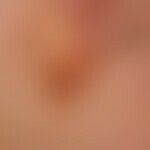Synonym(s)
DefinitionThis section has been translated automatically.
Following the Blaschko lines, possibly hemifacial (unilateral epidermal nevus), or even (more rarely) bilateral, epidermal hamartoma (epidermal nevus).
The common "hard type" epidermal hamartoma is linear or arranged in a whorled (blaschcoiod) pattern and is characterized by a hard, warty, dirty-brown surface.
The common epidermal hamartoma of the soft type is also arranged linearly or in a swirly pattern and is characterized by a soft, velvety, brownish surface.
Occurrence/EpidemiologyThis section has been translated automatically.
Incidence is estimated at 1:1000 births.
You might also be interested in
ManifestationThis section has been translated automatically.
Congenital or occurring in early childhood. 80% of epidermal hamartomas (nevi) are diagnosable in the first year of life.
LocalizationThis section has been translated automatically.
Face, neck, torso, extremities.
ClinicThis section has been translated automatically.
Bizarrely configured, often following a swirling line pattern (fountain pattern), linear or planar, often yellow or yellow-brown in infancy or early childhood, later brown or brown-black papules and/or plaques with a warty surface.
In the case of a cutaneous mosaic pattern, the border is usually abrupt towards the midline(nevus verrucosus unius lateralis).
Rarer is a bilateral or also generalized distribution pattern (see Fign.).
The unique swirling pattern (see below Blaschko lines) identifies the skin change as a cutaneous mosaic.
HistologyThis section has been translated automatically.
Differential diagnosisThis section has been translated automatically.
TherapyThis section has been translated automatically.
Progression/forecastThis section has been translated automatically.
The skin changes are usually only discreetly visible at the initial manifestation, inconspicuous, flat, surface-smooth. In the course of the years, continuously increasing, verrucous aspect.
Surprisingly, at times almost complete regression of an extensive verrucous nevus, with recurrence in the same location after several months, has been observed (see Fig.).
Note(s)This section has been translated automatically.
A special form of an epidermal hamartoma of the hard type (= naevus verrucosus) is the so-called "epidermolytic epidermal naevus". Its histological peculiarity is granular degeneration or acanthokeratolysis.
Another special form is the so-called "inflammatory epidermal nevus", also known by the acronym ILVEN.
Hamartomas of the skin are described as so-called "organoid epidermal nevi" in which the epidermis and/or skin appendages are altered (e.g. nevus sebaceus).
LiteratureThis section has been translated automatically.
- Kim R et al (2013) Verrucous epidermal nevus. Dermatol Online J 19: 20707
- Lapidoth M et al (2013) Treatment of verrucous epidermal nevus: experience with 71 cases. Dermatology 226:342-346
- Miranda LQ et al (2013) Analysis of mutations in the PIK3CA and FGFR3 genes in verrucous epidermal nevus. On Bras Dermatol 88(6 Suppl 1):36-38
- Rogers M et al (1989) Epidermal nevi and the epidermal nevus syndrome.
A review of 131 cases. J Am Acad Dermatol 20:476-88.
Incoming links (13)
Angora hair nevus syndrome; Aplasia cutis congenita (overview); Degeneration, granular; Epidermal nevus; Hyperkeratotic nevus; Lateral nevus verrucosus unius lateralis; Naevus; Naevus epidermal hard; Naevus, hard; Nevus durus; ... Show allOutgoing links (15)
Acanthosis; Blaschko lines; Degeneration, granular; Dermabrasion; Epidermal nevus (overview); Epigenetics; Excision; Ilven; Keratosis seborrhoeic (overview); Lateral nevus verrucosus unius lateralis; ... Show allDisclaimer
Please ask your physician for a reliable diagnosis. This website is only meant as a reference.














































